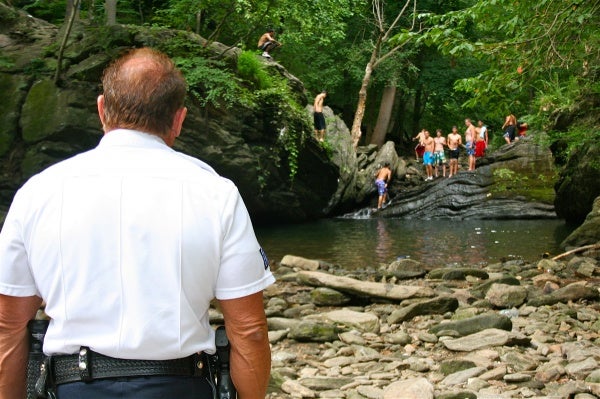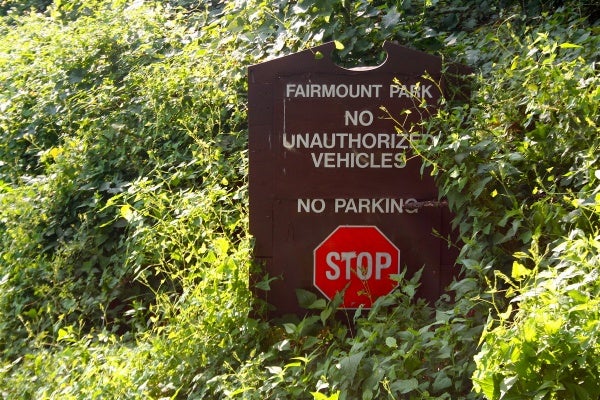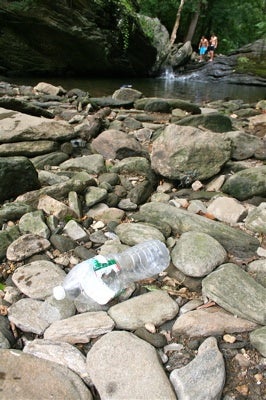Fighting the Devil: One Philadelphia police officer’s personal mission to patrol Devil’s Pool
Upon Google searching “Devil’s Pool Philadelphia,” the first thing that pops up is an NBC article about the area being closed last summer due to dirty conditions. But that can easily be overlooked, as other results are images of a rocky body of water surrounded by lush greenery and pages upon pages listing it as a hip, local swimming hole.
Sergeant Mike Vassallo of the Philadelphia Police Department’s 5th district sees it as many things, but a swimming hole isn’t one of them. And he worries about the impression the Internet might leave thrill seekers with.
“It’s on all these bucket lists,” he said, adding that several videos can be found on YouTube showing teenagers jumping about 60 feet from a bridge carrying sewage above. Devil’s Pool, he says, may only be 10-to-15 feet deep, depending on there being a dry spell or not.
Dump site
Vassallo, who describes himself as an environmentalist, says the once beautiful Leni-Lenape Native American holy site now looks more like a dumping ground.
“In the last couple of years, individuals frequenting the park are not cleaning up after themselves,” he said, adding that most activities that take place there are illegal anyway. “You find heroin bags, beer cans, trash, used condoms.”
But the problem doesn’t end with littering, illegal swimming and inappropriate behavior—the water itself is polluted, swimmers are constantly getting hurt jumping off rocks and bridges and illegal parking interferes with police and emergency vehicle response.
Many Devil’s Pool goers park on Livezey Lane—which has clearly marked ‘no parking’ signs—because the area can only be reached on foot. Others park their ATVs, motorcycles and dirt bikes on trails. Vassallo, along with members of the Friends of the Wissahickon, says several occasions of injured swimmers needing assistance come to mind.
Another instance of emergency vehicles not being able to make it down, Vassallo said, was when the horse stables near the Valley Green Inn burnt down in 2010.
Enough is enough
Because he was appalled at all of this, Vassallo took it upon himself to make visits to Forbidden Drive, as well as Devil’s Pool, when he was on the clock to help enforce rules—which are posted on a few trees all over the Wissahickon Valley Park.
Other officers often assist in his efforts since Devil’s Pool is located on the 14th district’s side of the creek. Together they aim to solve the problems before they get worse. The police also have Suzuki 650 CCs—two for each district—patrolling other areas of the park. But Devil’s Pool has to be reached on foot.
Vassallo has only done a handful of arrests over the past few weeks he started the project—one of which was because a man tried to run him over with an ATV—15-to-20 citations and 25-to-30 parking tickets.
Confronting swimmers
When Vassallo visits Devil’s Pool, he positions himself in a clearing and announces that everyone must get out of the water. He says people always stare blankly while teenagers scatter throughout the woods.
Vassallo approaches individuals to explain that there are five wastewater treatment plants that dump into the Wissahickon Creek. He doesn’t put it lightly—he basically tells them they’re swimming in toilet water.
The dirty conditions also worry Friends of Wissahickon (FOW). Executive Director Maura McCarthy said the pollution has been a major concern for the organization for more than five years and she’s glad the police have stepped in.
“Around 2007 or 2008 was the first year [Devil’s Pool] got very discovered,” she said. Last year the New York Times featured Devil’s Pool on its front page. Littering has become a big problem as well.
Clean up efforts
“You actually couldn’t see the ground,” she said, of the year FOW started doing trash pickups.
The FOW also installed trash cans—which sometimes remain unused—and trash bag dispensers. Some park goers leave their full trash bags rather than taking them out of the trails, but McCarthy said that’s better than cleaning up scattered trash.
The FOW cleans the area twice a week, she said.
Eau de toilette
As for the water, McCarthy described it as “pretty much the worst in any sub water shed of the Schuylkill River.”
According to a 2007 Stroud Water Research Center graph, the Wissahickon is ranked the third worst area stream in terms of pollution.
“During a dry period sometimes 90-to-100 percent has come through a waste water treatment plant—it’s treated sewage water,” McCarthy added. “Most of the time that water will not make you sick, however sometimes there’s an accident upstream.”
McCarthy sites a 2006 spill of raw sewage from an Ambler treatment plant, where traces of cyanide could be found in the Wissahickon. According to Philly.com, there was another spill the week prior.
“For both of those cases the public didn’t know of the discharge until days after,” McCarthy said.
She added: “Water quality is an issue, you will not die if you drink it, but I can’t guarantee you’ll feel very good either. But for children or immune compromised people, there could be real health risks.”
Similarly, Vassallo is more concerned about educating people, rather than ticketing and arresting them.
“I caught a mother the other day who was bathing her two- or three-month-old,” he said. “You can get eye infections and ear infections from that water.”
He added: “I have to be the guy that protects them from themselves.”
WHYY is your source for fact-based, in-depth journalism and information. As a nonprofit organization, we rely on financial support from readers like you. Please give today.











